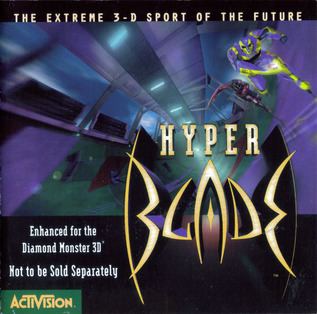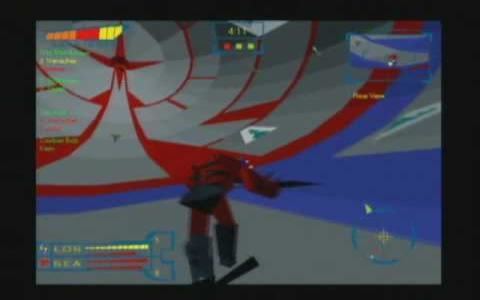Initial release date 1996 Platform Microsoft Windows | ||
 | ||
Developer(s) Wizbang! Software Productions Similar Hellbender, Heavy Gear II, Hunter Hunted, CyberGladiators, MechWarrior 2: Mercenaries | ||
Hyperblade gameplay
HyperBlade is an action video game, depicting a futuristic sport in a futuristic world. The sport is a mutated version of hockey, played in an egg-shaped arena rather than on a flat field or rink, which is loaded with weapons and deadly traps.
Contents

It was released by Wizbang! Software Productions in collaboration with Activision in 1996 for Windows 95, and serious graphics bugs are common in later operating systems. The game was to be released for the Sony PlayStation and Sega Saturn video game consoles as well, but was canceled months before its release.

Hyperblade game trailer
Gameplay

Brutality to an extreme is permitted, as advances in medical sciences have prevented once-fatal conditions (such as decapitation) from altering one's life. Each player must avoid the jaks of other players, as well as many arena objects. The players are allowed any enhancement, from steroids to bionic appendages. Each player is in a suit that allows maximum flexibility, strength, and protection, all of which are needed, colored to represent the country they play for. The players have one free gloved right hand, and a bladelike glove called a jak on their left. Players use this blade to pick up mines, swarves, and roks, as well as slash at their opponents (allowed). The primary method of transportation is skating, although jumping is very common to avoid obstacles and players.

HyperBlade is played on a court called a drome, an elliptical dome, each long end with a relatively small goal built into the wall. Many objects litter the drome, each one deadly in its own way. Examples are the turnstile, which one skates through to set spinning, injuring any who travel through it, the laser hurdle, which players must avoid at all costs, and the killball charger, which one skates through while carrying the rok to convert the rok into a killball, a high voltage electrocutor that can be thrown at others. Each team owns an arena, which can have any number of fixed objects in any position in the field..
The winner is the team with the most points (scored by throwing the rok into the goal) at the end of the three-period match. Each period can be 3 minutes, 5 minutes, or 7 minutes, depending on the options the player has enabled before the start of the game. If a team is totally annihilated, they can still win by having scored more points.
The sponsors give out awards to those teams that perform spectacular feats, such as the Supernova if a team racks up 30 points in a game, the Anvil if a team takes another entire team out for the season, and the Archer if all the player's shots on goal are goals.
Each team always has one goalie on the field. They also have two players out of four cycling in and out of the field at all times. When a player is killed or injured (the goalie is invulnerable to any attack except for mines), the player's spot cannot be filled until a goal is scored, or the period ends, and the body of the player is completely removed from the Drome. When a player is decapitated, his head is immediately magnetized and used as the rok, as the original rok (or, sometimes, previous head) vanishes.
The players vary greatly, some are light and fast, others are tough, slow and enforcer like, they also differ in other attributes, such as "rok handling".
Development
Nearly all of the polygons which form the players and environments are flat shaded, unusual at time when most games applied texture mapping. Lewis Peterson of Activision said of this that "Part of it was an aesthetic decision. More importantly, a texture-mapped polygon costs about 10 times the processor budget of a flat-shaded polygon, so we had to make a decision as to whether or not we wanted one big texture-mapped polygon, or a more detailed and fine-tuned characters. [sic]"
